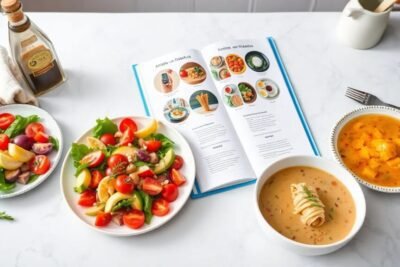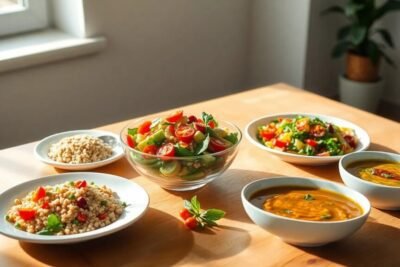
Delicious Diabetes-Friendly Recipes to Satisfy Your Cravings
- Introduction to Diabetes-Friendly Eating
- Understanding the Glycemic Index
- Essential Ingredients for Diabetes-Friendly Recipes
- Breakfast Recipes to Kickstart Your Day
- Wholesome Lunch Ideas for Balanced Nutrition
- Hearty Dinner Options for the Entire Family
- Delectable Snacks for When Cravings Hit
- Desserts That Won’t Spike Your Blood Sugar
- Tips for Meal Prep and Planning
Introduction to Diabetes-Friendly Eating
Managing diabetes effectively requires a comprehensive understanding of dietary choices, making diabetes-friendly eating a crucial aspect of daily life for those affected by this condition. The meals one consumes play a pivotal role in regulating blood sugar levels, maintaining an ideal body weight, and improving overall well-being. Balancing carbohydrates, proteins, and fats is essential for establishing a healthy meal plan that caters to individual nutritional needs while also offering enjoyment and satisfaction.
Carbohydrates are a primary focus for individuals navigating diabetes, as they directly impact blood glucose levels. Choosing whole grains, fruits, vegetables, and legumes can help stabilize blood sugar levels. Additionally, monitoring portion sizes is vital, as even healthy options can lead to spikes in glucose if consumed excessively. Besides carbohydrates, protein sources such as lean meats, beans, and nuts are fundamental in fostering a balanced diet. Proteins help support muscle maintenance and enhance satiety, which can lead to improved control over appetite and healthy eating habits.
Fats, often misunderstood, also play a crucial role in a diabetes-friendly diet. Selecting healthy fats, such as those found in avocados, olive oil, and fatty fish, can provide essential nutrients while supporting heart health, a significant concern for many individuals with diabetes. When integrated thoughtfully into daily meal planning, these macronutrients can harmonize to create meals that do not compromise on taste or satisfaction.
The importance of incorporating diabetes-friendly recipes cannot be overstated, as these dishes offer delicious options that align with nutritional guidelines. These recipes not only satisfy cravings but also contribute meaningfully to a balanced diet, making healthy eating both enjoyable and sustainable. As we explore various diabetes-friendly recipes throughout this blog post, we aim to provide flavorful food choices that enhance both health and happiness.
Understanding the Glycemic Index
The glycemic index (GI) is a ranking system that measures how quickly carbohydrate-containing foods raise blood glucose levels compared to a reference food, typically pure glucose or white bread. Foods with a high GI are quickly digested and absorbed, resulting in rapid spikes in blood sugar, while low-GI foods are digested more slowly, leading to a gradual rise in glucose levels. For individuals with diabetes, understanding the glycemic index is crucial for effective blood sugar management.
Incorporating low-GI foods into diabetes-friendly recipes can contribute to overall health and help maintain stable blood sugar levels. Examples of low-GI foods include legumes, whole grains, non-starchy vegetables, and most fruits. These foods not only provide essential nutrients and fiber but also keep you feeling full longer, reducing the likelihood of overeating or unhealthy snacking. On the other hand, high-GI foods, such as white bread or sugary snacks, should be limited, as they can lead to sudden insulin spikes and subsequent crashes, which can be detrimental to blood glucose control.
When planning meals or seeking diabetes-friendly recipes, it is important to be mindful of the glycemic index of various ingredients. By selecting low-GI options, individuals can create satisfying and nutritious dishes that cater to their dietary needs without sacrificing flavor. Additionally, pairing carbohydrate-rich foods with healthy proteins and fats can further enhance the meal’s overall glycemic response. This balanced approach allows for a diverse range of flavors and textures while keeping blood sugar levels in check.
Understanding the glycemic index empowers those with diabetes to make informed choices in their diet. Integrating this knowledge into everyday meal planning and recipe creation can lead to a more sustainable and enjoyable dietary lifestyle. Ultimately, knowing the impact of food on blood glucose can significantly enhance one's quality of life.
Essential Ingredients for Diabetes-Friendly Recipes
Creating delicious diabetes-friendly recipes requires an understanding of key ingredients that not only nourish the body but also help in managing blood sugar levels. Incorporating the right components is essential for crafting meals that satisfy cravings without compromising health. Below are some essential ingredients that can serve as pantry staples for anyone looking to prepare diabetes-friendly dishes.
Whole grains are one of the primary ingredients to consider. Options such as quinoa, brown rice, and barley are excellent choices as they are rich in fiber and nutrients. Whole grains help regulate blood sugar levels due to their slower digestion process, providing a steady source of energy and enhancing satiety.
Healthy fats also play a critical role in diabetes management. Incorporating sources like olive oil, avocados, and nuts can enhance the flavor of your meals while providing essential fatty acids that support heart health. These fats can also aid in the absorption of fat-soluble vitamins, which contribute to overall wellness.
Low-carb substitutes are another vital category of ingredients. For instance, using cauliflower rice or zucchini noodles can significantly reduce carbohydrate intake while still providing volume and texture to meals. Additionally, legumes such as lentils and chickpeas can serve as excellent protein sources, helping to control blood sugar spikes and keeping you feeling fuller for longer periods.
Moreover, spices and herbs can be incredibly beneficial in diabetes-friendly recipes. They not only add flavor without extra calories but also offer potential health benefits. For example, cinnamon has been studied for its ability to improve insulin sensitivity, making it an excellent addition to various dishes.
By familiarizing yourself with these essential ingredients, you can enjoy a variety of delicious diabetes-friendly recipes that support your health and satisfy your taste buds.
Breakfast Recipes to Kickstart Your Day
Starting your day with a nutritious breakfast is essential, especially for individuals managing diabetes. Incorporating diabetes-friendly recipes into your morning routine can provide you with sustained energy and maintain stable blood sugar levels. Here are some delightful options that prioritize flavor and nutrition.
One fantastic recipe is a Spinach and Feta Omelet. To prepare, whisk together a couple of eggs and season with salt and pepper. Pour the mixture into a heated non-stick pan, and add a handful of fresh spinach and crumbled feta cheese. Cook until the eggs are set and the spinach is wilted. This dish is rich in protein and fiber, which helps regulate blood sugar levels while also offering a delicious way to enjoy your vegetables.
Another great breakfast option is Overnight Oats with Chia Seeds. Combine rolled oats, almond milk, chia seeds, and a dash of cinnamon in a jar. Let it sit overnight in the refrigerator. In the morning, top it with fresh berries and a spoonful of almond butter for added flavor and healthy fats. This recipe is not only easy to prepare but also provides complex carbohydrates that slowly release energy, preventing blood sugar spikes.
For those looking for a warm breakfast, consider preparing a Quinoa Breakfast Bowl. Cook quinoa and mix it with almond milk, a drizzle of honey, and your choice of nuts and seeds. Quinoa is a complete protein and has a low glycemic index, making it ideal for maintaining healthy blood sugar levels. Adding nuts, such as walnuts or pumpkin seeds, further enhances the nutritional profile of this breakfast.
These breakfast recipes are flavorful, varied, and strategically designed for individuals with diabetes. With options that include high protein and healthy fats, mornings can be both enjoyable and beneficial for managing your health.
Wholesome Lunch Ideas for Balanced Nutrition
For those managing diabetes, selecting the right lunch can significantly influence energy levels and blood sugar control throughout the day. Incorporating diabetes-friendly recipes into your meal planning is essential to create satisfying and nutritious lunches that cater to your dietary needs. By focusing on whole, nutrient-dense ingredients, you can prepare meals that not only please your palate but also help keep your blood sugar levels stable.
A great starting point for a balanced lunch is a quinoa salad loaded with fresh vegetables. Quinoa is a complete protein and a low glycemic index food, making it an ideal choice for those with diabetes. Combine cooked quinoa with diced cucumbers, cherry tomatoes, and bell peppers, and toss in a lemon vinaigrette for a refreshing dish. Adding a source of healthy fat, such as avocado, can enhance satiety and promote heart health.
Another appetizing option is a wrap made with whole grain tortillas. Fill the tortilla with lean proteins like turkey or grilled chicken, leafy greens, and slices of avocado. These wraps are versatile and can be customized according to individual preferences, allowing for a delightful mixture of textures and flavors. Including hummus as a spread provides additional fiber and prevents the wrap from becoming too dry.
For those who enjoy soups, consider preparing a lentil and vegetable soup. Lentils are a fantastic source of protein and fiber, contributing to longer-lasting fullness. By incorporating a variety of colorful vegetables, such as carrots, spinach, and zucchini, this soup becomes not only nutrient-rich but also vibrant in taste.
Implementing diabetes-friendly lunch recipes into your daily routine can lead to satisfying meals that support your nutritional goals. These balanced options are not only delicious but also provide essential ingredients that help maintain energy and stabilize blood sugar levels throughout the day.
Hearty Dinner Options for the Entire Family
Creating meals that cater to everyone’s tastes while being mindful of dietary restrictions can sometimes be a challenge. However, you can prepare delightful dinner options that not only satisfy cravings but are also diabetes-friendly. These hearty recipes provide a perfect blend of comfort and nutrition, ensuring that family meals remain enjoyable for all members, regardless of their dietary needs.
One fantastic option is quinoa-stuffed bell peppers. This dish combines colorful bell peppers with a mixture of quinoa, black beans, and diced tomatoes, seasoned with herbs and spices. Not only is it packed with protein and fiber, but it also presents beautifully, making it a wholesome choice for a family dinner. The freshness of the ingredients aligns well with the principles of diabetes-friendly recipes, thereby supporting healthy eating.
Another great recipe is baked lemon herb chicken served with a side of roasted vegetables. The chicken is marinated in a mixture of lemon juice, garlic, and fresh herbs, creating a savory and aromatic dish. Accompanied by a variety of roasted seasonal vegetables such as zucchini, carrots, and broccoli, this meal is both satisfying and visually appealing. It highlights how gourmet flavors can be incorporated into diabetes-friendly alternatives without sacrificing taste.
Additionally, you might consider preparing lentil soup that is rich in nutrients. This hearty soup can be made with an assortment of vegetables and spices, offering warmth and comfort. Lentils are a fantastic source of protein and fiber, making them an excellent choice for those monitoring their blood sugar levels. By exploring various vegetables and seasonings, families can personalize this dish, ensuring that it gains widespread approval.
Ultimately, with thoughtful planning and creative recipes, family dinners can be transformed into delightful experiences. By embracing diabetes-friendly meals, everyone at the table can indulge without compromising health, leading to enjoyable and nutritious dining experiences.
Delectable Snacks for When Cravings Hit
Healthy snacking plays a crucial role in managing blood sugar levels and preventing exaggerated hunger between meals, making it an essential practice for individuals living with diabetes. Choosing the right snacks not only helps in stabilizing blood glucose but also allows for enjoyment throughout the day. Here are some diabetes-friendly recipes that are both satisfying and simple to prepare.
One delightful option is the cucumber and hummus plate. Slice fresh cucumbers and serve them with a side of homemade hummus made from chickpeas, tahini, lemon juice, and garlic. This snack is rich in fiber and protein, which can help maintain blood sugar levels while providing a crunchy texture that can satisfy your craving for something savory.
Another excellent snack choice is yogurt with berries and nuts. Opt for plain, low-fat Greek yogurt as a base, and top it with a handful of fresh or frozen berries for a touch of natural sweetness. Adding a sprinkle of nuts such as almonds or walnuts not only adds a delightful crunch but also boosts the snack's protein content. This nutritious option is great for curbing sweet cravings without compromising on health.
Vegetable sticks with guacamole are another fantastic and diabetes-friendly snack. Slice carrots, bell peppers, and celery into sticks and pair them with a creamy guacamole made from ripe avocados, lime juice, and spices. This combination offers healthy fats and essential vitamins, nourishing your body while keeping your cravings in check.
Finally, air-popped popcorn can serve as a wholesome, low-calorie snack. Seasoning it with herbs and spices can enhance its flavor without adding unnecessary sugar or calories. Remember to enjoy these snacks in moderation, and you'll find these delectable diabetes-friendly recipes can support both your health and satisfy your cravings.
Desserts That Won’t Spike Your Blood Sugar
Satisfying a sweet tooth can be challenging for those managing diabetes, but it is indeed possible with the right diabetes-friendly recipes. Innovations in dessert-making have led to the development of options that are both delicious and suitable for individuals who need to monitor their blood sugar levels. By utilizing natural sweeteners and health-conscious ingredients, these recipes allow for indulgence without the guilt associated with traditional sweets.
One popular strategy in creating diabetes-friendly desserts is the use of natural sweeteners such as stevia, erythritol, or monk fruit. These alternatives provide sweetness without the high glycemic impact of refined sugars, making them ideal for those on a restricted diet. For instance, a delectable chocolate avocado mousse can be prepared using ripe avocados blended with cocoa powder and a dash of stevia, delivering a creamy, rich flavor while being low in carbohydrates.
Another option is to incorporate whole grains and healthy fats into desserts. Consider a recipe for almond flour cookies, which not only provide a nutty flavor but also contain nutrients that can benefit overall health. These cookies can be sweetened subtly with sugar-free chocolate chips or dried fruits that offer additional fiber and vitamins. Utilizing fruit as a natural sweetener is also effective—for example, baked apples with cinnamon not only satisfy cravings but also provide essential nutrients and fiber, aiding in digestion.
Moreover, creating desserts using yogurt can be an excellent choice. Greek yogurt, in particular, is high in protein and can be combined with various toppings such as berries, nuts, or seeds, yielding a multifaceted flavor experience. These combinations can cater to various taste preferences while adhering to a diabetes-friendly diet.
Overall, by focusing on innovative uses of natural ingredients and sweeteners, it is possible to indulge in desserts that complement a diabetes-friendly lifestyle. Enjoying these treats can bring satisfaction without causing harm, proving that healthy eating doesn't have to be devoid of pleasure.
Tips for Meal Prep and Planning
Meal prepping and planning play a pivotal role in maintaining a diabetes-friendly diet, as they not only support healthy eating habits but also help in managing time effectively during busy weeks. With thoughtful preparation, it is feasible to create delicious diabetes-friendly recipes that cater to specific nutritional needs while saving effort in the kitchen.
One effective strategy is to select a day each week dedicated to meal preparation. This could involve cooking in bulk and storing meals in portion-controlled containers. Such an approach allows individuals to plan their meals ahead, reducing the temptation to opt for unhealthy choices when time is short. Incorporating a variety of proteins, whole grains, and plenty of vegetables into the menu is essential. Consider batch cooking recipes, such as hearty soups or stir-fries that can be easily reheated. These meals can sustain energy levels and prevent sugar spikes, thus making them ideal for someone managing diabetes.
In addition to batch cooking, organizing a shopping list before heading to the grocery store can ensure that only diabetes-friendly ingredients are purchased. Aim to stock up on items such as leafy greens, whole grains, lean meats, and low-sugar fruits. Prepare ingredients in advance, like chopping vegetables or marinating proteins, which can significantly reduce cooking time during the week. A well-prepared pantry and fridge can also encourage experimentation with new diabetes-friendly recipes.
Finally, don’t forget about flexibility. While meal planning is beneficial, being adaptable in your food choices is equally important. It is perfectly acceptable to swap ingredients within recipes, which can keep mealtime exciting and enjoyable. Adopting these meal prep strategies not only supports a diabetes-friendly lifestyle but also fosters long-term health and well-being.










